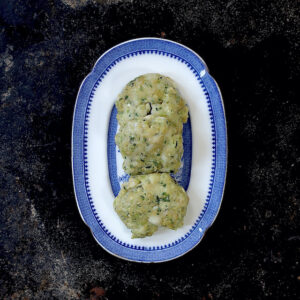Asian Fish Cakes
Many of you know the woman behind the IK hails from Detroit. She is of Eastern European extraction. Sadly, she has never traveled to Asia, though she hopes to, one fine day.

It may be surmised from the above that the IK has no expertise in matters Asian, culinary or otherwise. Admiration? A great deal. But this does not translate to expertise. For the IK to make fish cakes utilizing Southeast Asian ingredients like Nam Pla or lemongrass and blithely dub her creation “Asian” seems slightly, well, careless. “Faux Asian Fish Cakes” is entirely more appropriate. But call a recipe “faux” and watch the internet search engine smack its virtual forehead and call for a vodka tonic. So despite these tasty little numbers being the most pretending of the pretenders–i.e, wildly inauthentic–the IK, sighing, is gonna cop to seo and say “Asian Fish Cakes.” All apologies to real Asian food, including the Thai fish cake known as tod mun. This recipe has nothing to do with that.
Okay?
One final confession. In writing this recipe, I went to consult a Thai cookbook just to see how far I’d strayed from the mothership. And realized that I, um, don’t actually have any Thai cookbooks. You know, from Thailand?
When I confessed this oversight to John, he laughed and said, “I’m sure it won’t take you long to remedy that.”
In the interim, I hopped on the internet, where I learned tod mun recipes vary. (There’s a shock.) Some call for oyster sauce. Others use red curry paste; some use sweet chili sauce. I am not fond of oyster or sweet chili sauces. That is, I’ve yet to find bottled products that aren’t heavy on salt, sugar, and general gloppiness.

Before getting the to recipe, some throat clearing.
A note on spicing: you have control over how mild or spicy your fish cake is. A tablespoon of fish sauce, a teaspoon of hot dried pepper, and you have a mild result; increase both ingredients, increase the zing. Not sure what you’re after? Fry a small test patty, taste for seasoning, finish cooking accordingly. It takes longer to read than to do.
Another way: Cook a milder fish cake–sure to please everyone–and make a spicy dipping sauce for the hardcore weirdos who like their food incendiary (ahem).
About the dipping sauce: This is the IK bog standard dipper: fish sauce gussied up with lime juice and mirin. This time around I added minced lemongrass. My bowl got some minced hot red pepper There is no real recipe for this: mix and taste until you like it.
 You need a food processor or powerful blender for this. My food processor complained bitterly when I dumped the ingredients into the workbowl. You’d think I asked to do something other than take up counter space.
You need a food processor or powerful blender for this. My food processor complained bitterly when I dumped the ingredients into the workbowl. You’d think I asked to do something other than take up counter space.
These are easy, easy, easy to make; the hardest part of the entire business is cleaning up. Ammonia helps get the oil spatters off your stove. I pour used cooking oil off into a glass canning jar, which I keep in the refrigerator. When it’s full, I pitch it. If anyone has some ecologically better way, I’d love to hear it.
Incidentally, should you have fish cake or two left over, pretend none are left. Wrap the fish cakes in foil and hide them in the fridge behind the diet mayonnaise. The next day, tuck your fish cakes into a sandwich with mustard, mayonnaise, and salad greens. Eat, preferably with potato chips.
Is this selfish? That depends. How much have you sacrificed in the grand scheme of things? What have you given up in life so that others in your household may live?
Only you can answer these questions.
Finally, ask yourself this: did you cook the fish cakes?

Asian Fish Cakes
inspired by Diana Henry’s Moroccan Fish Cake recipe in Plenty
yield: 14 medium-sized fish cakes
enough for 2-3 adults
1 1/2 pounds white fish filet: whatever is fresh, inexpensive, and sustainable where you live.
1/2 teaspoon-1 teaspoon hot red pepper flakes
2 large garlic cloves, peeled and roughly chopped
1 scallion, white tip and bottom sliced off, cleaned, peeled sliced into three pieces
approximately 4 ounces cilantro leaves (about 1/2 bunch in the United States) See note, below
approximately 4 ounces parsley leaves (about 1/2 bunch in the United States)
1 large egg, beaten
zest of one lime, either microplaned or very finely minced (any larger and the processor will not chop it up)
4 grinds of the pepper mill (about 2 teaspoons)
1-2 tablespoons Vietnamese fish sauce (Nam Pla)
1 tablespoon mirin
Flour for forming the cakes
Canola or peanut oil for cooking the cakes; I use Spectrum organics canola oil for high heat
For the dipping sauce:
Vietnamese fish sauce
rice wine vinegar or, if you can spring for it, a bottle of Oshawa Organic Brown Rice Vinegar
fresh lime juice
hot red pepper (optional)
1 stalk of lemongrass, peeled and minced
You will need a food processor or powerful blender for this recipe.
As this recipe calls for high-heat frying, you may want to open kitchen windows and/or run ventilation fan. And, of course, take reasonable care.
It is important to keep the fish cool while preparing this dish. If it’s a hot day, or your kitchen is warm, keep fish refrigerated when not using.
For ease, I stir the lime zest, pepper, nam pla, and mirin into the beaten egg before pouring it into the food processor.
To prepare the fish mixture, put the fish, red pepper flakes, garlic, scallion, cilantro, parsley, egg, lime zest, nam pla, and mirin into the food processor fitted with the steel blade. Pulse until just blended; you want paste, not a total mush. If you are unsure about how spicy you want the cakes, start with smaller amounts of fish sauce and red pepper flakes.
Tip mixture into a bowl. Fish mixture can be covered and refrigerated up to 4 hours at this point.
To fry the fish cakes:
Have about a quarter cup of flour spread in a flat dish.
Have a tray lined with paper towels.
Place a 10-12 inch sauté pan on the stove. Pour in about an inch of canola or peanut oil. Turn the burner to high.
When the oil is shimmering, flour your hands and make a small test patty. It will cook in about a minute. Turn down the heat under the pan while working with your test patty. Taste and adjust seasoning by adding fish sauce/hot pepper if necessary.
Finish cooking the fish cakes. Crank the heat back up. Flour hands again. Make your cakes: I am lazy and make mine hockey puck size. If you prefer making smaller or larger fish cakes, go ahead. Fish being fish, they cook quickly, perhaps 2 minutes per side. As they cook, move cakes to the paper-lined tray so oil can drain off.
Fish cakes are best served hot, but also good at room temperature and even cold.
Make the dipping sauce by mixing the fish sauce, mirin or brown rice vinegar, lime juice, lemongrass, and optional hot pepper to your taste.
Serve with salad greens, sliced radishes, and more limes. Also good with rice or noodles.
Notes: I used Petrale sole, which is expensive, but it was the freshest when I was shopping. Cheaper fish like tilapia, cod, or rockfish would be fine here.
If you despise cilantro, use all parsley.
I dispose of used cooking oil by pouring it off into a glass canning jar, which I keep in the refrigerator until full, then toss.
As fresh fish is highly perishable, I would not advise keeping leftovers refrigerated more than one day.





